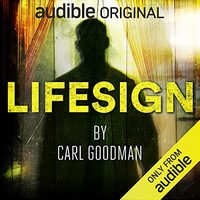 Lifesign
Lifesign
by Carl Goodman, Louise Brealey (Narrator)
DETAILS: Series: DI Eva Harris, #2 Publisher: Audible Originals Publication Date: September 23, 2021 Format: Unabridged Audiobook Length: 13 hr., 6 min. Read Date: May 10-13, 2022

What’s Lifesign About?
DI Ava Harris continues her work outside her specialty and keeps proving she’s pretty good at it—the book opens with a great action sequence as she leads a team on a raid.
After that, Harris is taken to what looks like a lab—a lab (or an art installation?) full of many well-preserved dead bodies (partial or intact). It’s disturbing for her and the rest of the police (and the poor teen who found it)—it’s disturbing for the listener, too. Once again, Harris and her detectives are on the hunt for a possible serial killer.
It takes a lot of time and effort for the detectives to find a common link between the victims that will hopefully lead them to a suspect. But once they come up with a theory, it indicates that there are more victims to be found—possibly still living. The pressure, which had been strong already because of the number of bodies, becomes even stronger—they have lives to save.
Paging Aldous Leekie
20/20 introduced us to a quasi-religious group, with some shades of medical science that’s a little beyond what’s actually possible right now. Eva is concerned another one of their members is involved in this case as well.
She’s not wrong, but she’s not quite right, her investigation leads to her coming across several people who’ve taken their medical research even further. There’s a strong vein of transhumanism running throughout this novel, adding a flavor to this that you don’t get in Police Procedurals.
We’re not quite talking Cyberpunk-level weirdness. This is about halfway between where we are now and Johnny Mnemonic/Mirrorshades.
There’s some more thoughtful, serious, “how can we battle diseases in new ways” types of science involved, but there are also some more frivolous (for a lack of a better term) uses of this science, too. There are a couple of scenes in a nightclub that feel like they’re straight from the Orphan Black Season 1 episodes with the Neolution club full of body modifications.
I love that Goodman’s able to take a pretty solid police procedural and mix this in so that the books become more than what they are (although, honestly, I’m betting they’d be worth the time without it)—you get something to think about, react to—maybe even research—in addition to the mystery.
My Inner Prude*
* This is an observation/description, not evaluative. I know I have a number of readers who’d want to know this before grabbing the book (and a number who don’t care, too).
There are a few scenes in this that don’t bring out my Inner Prude—but keep it bubbling right below the surface. Thankfully, Eva’s inner prude is pretty loud, too, so she keeps herself at arm’s length from those situations—well, maybe a cubit’s length anyway.
There’s also a scene of assault that’s going to be too much for many—and almost me—but it’s brief and easily skippable. It will be referred to later, but without details.
A Strange Rabbit Trail
Maybe because the same person recommended the two series to me, maybe because there’s a level of reflection on things beyond the case that are common between the two series, but at some point, I asked myself, “What would (Peter Grainger’s) DC Smith think of this case? How would he tackle this?”
I had to stop the audio and ponder this for a while—I think Eva wouldn’t be that great at any of his cases (although she might be quicker to move on some suspects), but DC dealing with the transhumanism angle is a little thought experiment that’s going to linger with me.
And very likely only me. So I won’t bore you with any of my thoughts. I just had to mention it.
How’s the Narration?
I’m going to largely just copy what I said before: Brealey nailed this—she captures Harris’ analytical approach, the distance she’s keeping from her team and the assignment—and then how that distance crumbles—and general unease with some aspects of the assignment. She also does a great job portraying the rest of the cast, and the unexpected attitudes from some of the suspects.
I don’t know if I can separate my appreciation of Brealey’s work from Goodman’s, and don’t really see the point in trying. In my mind, they’re a package deal and should stay that way.
So, what did I think about Lifesign?
This is a pretty gripping read—and as I said, there’s more to it than just the thriller/procedural. As I said before, it’s a great combination and one that I want more of (assuming they’re done as well as Goodman does it)
The key to the enjoyment of both of these books is Eva Harris. She’s this great combination of confidence and doubt; conviction and (hidden) rage; skill and dumb luck. Also, I love seeing her struggle with enforcing the law and seeking justice, while dealing with her instinct of circumventing the law in order to achieve the right result. She’s not the first or only police protagonist to balance these things, but the way Goodman pursues it is what is going to keep me coming back as long as he produces them. Think Fiona Cummings with a different group of psychological issues and without the casual drug use, and you’re most of the way to understanding Eva.
I’m hooked, if there’s a third installment in this series, I’ll be there with bells on. In the meantime, if you have the means, I strongly suggest you give this a shot.

![]()



Read Irresponsibly, but please Comment Responsibly